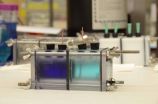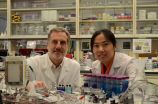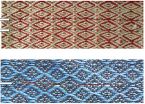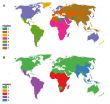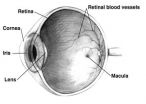INFORMATION:
Other researchers on this project were Jia Liu, postdoctoral fellow and Wulin Yang, graduate student, both in environmental engineering. The researchers have filed a preliminary patent on this work.
The King Abdullah University of Science and Technology supported this work.
Low-grade waste heat regenerates ammonia battery
2014-12-03
(Press-News.org) An efficient method to harvest low-grade waste heat as electricity may be possible using reversible ammonia batteries, according to Penn State engineers.
"The use of waste heat for power production would allow additional electricity generation without any added consumption of fossil fuels," said Bruce E. Logan, Evan Pugh Professor and Kappe Professor of Environmental Engineering. "Thermally regenerative batteries are a carbon-neutral way to store and convert waste heat into electricity with potentially lower cost than solid-state devices."
Low-grade waste heat is an artifact of many energy-generating methods. In automobiles, waste heat generated in winter is diverted to run the vehicle heating system, but in the summer, that same waste heat must be dissipated to the environment. Coal, nuclear and other power plants require high heat to produce electricity, but after producing electricity the excess waste heat is routed to cooling towers to dissipate. Many industrial sites, geothermal sources or solar generating plants also create low-grade heat that is wasted.
The researchers want to take this waste heat and capture it to produce more power. Other researchers have tried a variety of methods, but most produce too little power to be workable, or they cannot provide a continuous resource. Logan and his team are using a thermally regenerated ammonia-based battery that consists of copper electrodes with ammonia added only to the anolyte -- the electrolyte surrounding the anode.
"The battery will run until the reaction uses up the ammonia needed for complex formation in the electrolyte near the anode or depletes the copper ions in the electrolyte near the cathode," said Fang Zhang, postdoctoral fellow in environmental engineering. "Then the reaction stops."
This type of battery would be useless as a constant source of electricity if the reaction were not regenerative. Using low-grade waste heat from an outside source, the researchers distill ammonia from the effluent left in the battery anolyte and then recharge it into the original cathode chamber of the battery.
The chamber with the ammonia now becomes the anode chamber and copper is re-deposited on the electrode in the other chamber, now the cathode, but formerly the anode. The researchers switch ammonia back and forth between the two chambers, maintaining the amount of copper on the electrodes.
"Here we present a highly efficient, inexpensive and scalable ammonia-based thermally regenerative battery where electrical current is produced from the formation of copper ammonia complex," the researchers report in the current issue of Energy and Environmental Science. They note that the ammonia liquid stream can convert the thermal energy to electrical energy in the battery. "When needed, the battery can be discharged so that the stored chemical energy is effectively converted to electrical power."
One of the problems with previous methods was that the amount of energy produced in, for example, a system using salty and less salty water to generate electricity, was too small relative to the amount of water used. The thermally regenerative ammonia battery system can convert about 29 percent of the chemical energy in the battery to electricity and can be greatly improved with future optimization.
The researchers produced a power density of about 60 watts per square meter over multiple cycles, which is six to 10 times higher than the power density produced by other liquid-based thermal-electric energy conversion systems. The researchers note that the current thermally regenerative ammonia battery is not optimized, so that tinkering with the battery could both produce more power and reduce the cost of operating the batteries.
The researchers were able to increase power density by increasing the number of batteries, so that this method is scalable to something that might be commercially attractive.
ELSE PRESS RELEASES FROM THIS DATE:
Are there safe and effective treatments for hereditary angioedema in children?
2014-12-03
New Rochelle, NY, December 3, 2014--Hereditary angioedema (HAE), a rare genetic disease that causes recurrent swelling under the skin and of the mucosal lining of the gastrointestinal tract and upper airway, usually first appears before 20 years of age. A comprehensive review of the therapies currently available to treat HAE in adults shows that some of these treatments are also safe and effective for use in older children and adolescents. Current and potential future therapies are discussed in a Review article in a special issue of Pediatric Allergy, Immunology, and Pulmonology, ...
NASA tracks intensifying Typhoon Hagupit
2014-12-03
Typhoon Hagupit continues to intensify as it continued moving through Micronesia on Dec. 3 triggering warnings. NASA's Aqua satellite passed overhead and captured an image of the strengthening storm while the Rapidscat instrument aboard the International Space Station provided information about the storm's winds.
The International Space Station-RapidScat instrument monitors ocean winds to provide essential measurements used in weather predictions, including hurricanes. "RapidScat measures wind speed and direction over the ocean surface and captured an image of Hagupit ...
Researchers develop clothes that can monitor and transmit biomedical info on wearers
2014-12-03
This news release is available in French.
Quebec City, December 3, 2014--Researchers at Université Laval's Faculty of Science and Engineering and Centre for Optics, Photonics and Lasers have developed smart textiles able to monitor and transmit wearers' biomedical information via wireless or cellular networks. This technological breakthrough, described in a recent article in the scientific journal Sensors, clears a path for a host of new developments for people suffering from chronic diseases, elderly people living alone, and even firemen and police officers.
A ...
Mapping human disease: 'Not all pathogens are everywhere'
2014-12-03
Researchers at North Carolina State University have for the first time mapped human disease-causing pathogens, dividing the world into a number of regions where similar diseases occur.
The findings show that the world can be separated into seven regions for vectored human diseases - diseases that are spread by pests, like mosquito-borne malaria - and five regions for non-vectored diseases, like cholera.
Interestingly, not all of the regions are contiguous. The British Isles and many of its former colonies, such as the United States and Australia, have similar diseases ...
Tinkering with the Tao of pandas
2014-12-03
Good news on the panda front: Turns out they're not quite as delicate - and picky - as thought.
Up until now, information gleaned from 30 years worth of scientific literature suggested that pandas were inflexible about habitat. Those conclusions morphed into conventional wisdom and thus have guided policy in China. But a Michigan State University (MSU) research associate has led a deep dive into aggregate data and emerged with evidence that the endangered animal is more resilient and flexible than previously believed.
Vanessa Hull is a postdoctoral research associate ...
Small drains mean big problems at 'baby beaches'
2014-12-03
Irvine, Calif., Dec. 3, 2014 - High fecal counts frequently detected at so-called "baby beaches" may not be diaper-related. UC Irvine researchers found that during summer months, small drainpipes emptying into enclosed ocean bays have a disproportionate impact on calmer waters. The findings were published Tuesday in the journal Environmental Science & Technology.
Researchers have long known that creeks and tributaries foul coastal waters with major winter storm runoff. But dry seasons like the one that just concluded can spell potential peril, too. Runoff from watering ...
Scientists detect brain network that gives humans superior reasoning skills
2014-12-03
When it comes to getting out of a tricky situation, we humans have an evolutionary edge over other primates. Take, as a dramatic example, the Apollo 13 voyage in which engineers, against all odds, improvised a chemical filter on a lunar module to prevent carbon dioxide buildup from killing the crew.
UC Berkeley scientists have found mounting brain evidence that helps explain how humans have excelled at "relational reasoning," a cognitive skill in which we discern patterns and relationships to make sense of seemingly unrelated information, such as solving problems in unfamiliar ...
Wireless nanorod-nanotube film enables light stimulation of blind retina
2014-12-03
Scientists have developed a new light-sensitive film that could one day form the basis of a prosthetic retina to help people suffering from retinal damage or degeneration. Hebrew University of Jerusalem researchers collaborated with colleagues from Tel Aviv University and Newcastle University in the research, which was published in the journal Nano Letters.
The retina is a thin layer of tissue at the inner surface of the eye. Composed of light-sensitive nerve cells, it converts images to electrical impulses and sends them to the brain. Damage to the retina from macular ...
Separate and unequal in suburbia
2014-12-03
A new research brief from the US2010 Project probes the status of minorities in American suburbs. Suburbs in 2010 were as racially and ethnically diverse as were central cities in 1980, and that diversity is still increasing. Yet minorities are not finding equal access to the American dream in the suburbs where they live, a lesson illustrated recently by Ferguson, MO.
Suburbia has always been less segregated than central cities. Segregation is slowly declining between suburban blacks and whites, but has stayed about the same for Hispanics and Asians over three decades. ...
Glass houses: Your personality helps predict your real estate choices
2014-12-03
Do you consider yourself a conscientious person? Then sign up for a fixed-rate mortgage. Neurotic? You'll probably opt for home ownership over renting.
According to a new study published in the Journal of Behavioral and Experimental Economics, personality traits are strong indicators of real-estate decisions. The research, by Dr. Danny Ben-Shahar of Tel Aviv University's Faculty of Management and doctoral candidate Roni Golan of the Technion Institute of Technology, finds a correlation between personality and individual real estate choices, and a follow-up study by the ...
